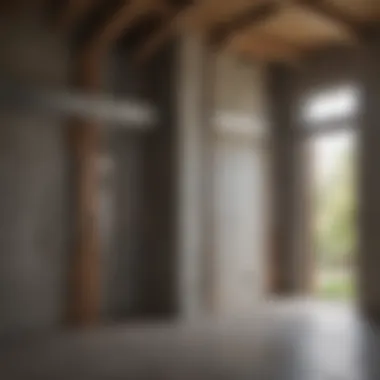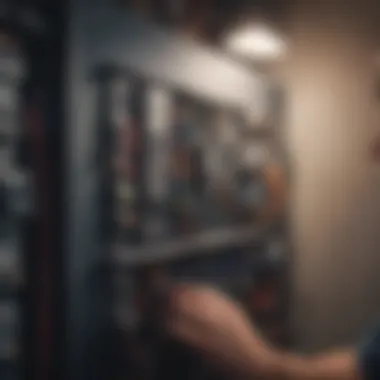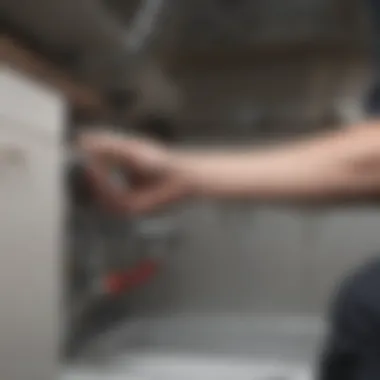Home Inspection Checklist: Key Components Revealed


Intro
Home inspection represents a critical juncture in the home buying process, acting as a safeguard against unforeseen issues. Buyers often invest significant capital in their real estate purchases. Understanding what inspectors assess enables potential buyers to make informed decisions. Several key components factor into a comprehensive inspection.
These evaluations extend beyond the obvious points like appliances and fixtures. They explore deeper structural elements that are vital for a home’s integrity. Meeting the requirements of various components leads into thorough knowledge not simply about condition, but about the associated costs that may arise post-purchase. This narrative reveals all essential checkpoints of home inspections.
Structural Integrity
Undoubtedly, the foundation is the backbone of a building. Inspectors look vehemently for cracks or shifts in the foundation. Signs of settlement can indicate deeper underlying issues. Depending on the material of the home, any visible bowing or shifting signals further investigation is needed.
Similarly, they also examine walls, roofs, and floors. Sidewalls and load-bearing supports need scrutinizing. Factors contributing to previously indicated changes can often be tied to moisture, representing an area that buyers should be keen on.
Rooftops undergo evaluation to determine age, material, and overall upkeep. The structure is vital. Broken shingles or signs of wear can result in larger expenses for homeowners. Identifying evidence of leaking or improper drainage is paramount.
Electrical Systems
One of the more complicated systems to evaluate is the electrical setup. Inspectors review the main panel, checking for rust and any inadequacies in configurations. Faulty switches and wires are common nods to heavier strategic issues within electrical distribution. A definitive approach is to have GFCI or AFCI coverings in vulnerable locations.
Inspectors often perform checks on outlets and ensure grounding is present. They make it clear that insufficient grounding is a significant safety risk. The requirement for state compliance adds another winning layer for relevant approvals and average estimates about strength and performance rates of your building. This part of evaluation can also unearth core issues if not coordinated well, causing hazardous exposures.
Plumbing
Plumbing systems sustain extensive value for the well-being of any home. Inspectors meticulously search for leaks across fixtures, water supply lines, and drainage systems. They pay careful attention to water heaters too, validating their operational age or noting signs of deterioration.
Sump pumps, particularly in places prone to flooding, also receive necessary attention. Arm-flushing and performing tests may indicate sizing either advantageous or failing. An aspect of inspection sometimes overlooked involves water quality. A chemical electrophoresis test can provide an insight into prescriptive water treatment.
HVAC Systems
For any registered regions with distinct seasons, HVAC values significantly rise. Inspectors conduct the rounds checking heating, ventilation, and air-conditioning mechanisms including directive airflow. The degree of wear or the life expectancy of units becomes apparent with usage metrics stemming from regular maintenance logs the property offered. It is prudent to emphasize the essential goal of optimum humidity can indeed touch both health and efficiency metrics for homeowners.
Additional Considerations
Do not disregard additions such as driveways, patios, and decks. Issues generally arise due to signs of improper drainage or wearing issues from usage attributes. Yearly inspections occur to remedy this concern obviating costly repairs.
Reminder Gaining knowledge about home inspection outcomes can prove exponentially beneficial to navigate contractual trajectories without fear. Therefore, once equipped suitably, collecting data hinges on risk mitigation across various parameters, evidencing reasons valid for consideration in every sector of the real estate market.
Understanding Home Inspections
Home inspections play a critical role in real estate transactions. For buyers, a thorough insulation can be the defining factor between making a wise investment or acquiring a looming headache in the form of hidden issues. Sellers, on the other hand, can benefit from inspections to pinpoint and resolve potential problems before listing their property, enhancing marketability. The repercussions of neglected home inspections can affect warranties, insurance claims, and even financing options.
Definition and Purpose
A home inspection is an unbiased evaluation of a property's physical condition. This process usually occurs after a purchase agreement but before the closing process itself. The primary aim is to assess properties thoroughly, verifying structural integrity, safety, and functionality of systems like plumbing and electrical operations. The report generated becomes an essential component during negotiations and can streamline the buying or selling process.
Importance for Buyers and Sellers
Understanding the significance of home inspections benefits both parties. For buyers, knowing the internal and external conditions helps mitigate risks. It allows for making informed decisions, sometimes influencing the offer price or requiring repairs before purchase. When a home inspection reveals issues needing immediate attention, buyers gain leverage in negotiations. For sellers, addressing these complications proactively can impress prospective purchasers, potentially distinguishing their property in a competitive market.
In essence, whether buying or selling, being well-informed through a home inspection directly influences transaction success and future homeowner satisfaction. Any real estate stakeholde can gain massive insight from a thorough check-up, thus eliminating post-sale surprises.
Key Areas of Focus in Home Inspections


Home inspections serve a vital role in assessing the condition of a property. They offer insights into various components that can impact value and safety. During an inspection, professionals concentrate on specific aspects. These include structural integrity, exterior condition, and interior components, among others. Understanding these key areas is essential for both buyers and sellers, as it influences decision-making at numerous levels. Through thorough evaluations, inspectors can reveal potential issues, guiding stakeholders before moving forward in the real estate process.
Structural Components
Foundation
The foundation of a home is crucial. It supports the entire structure. Inspectors assess the integrity of the foundation to detect any signs of cracks or shifting. Any significant foundation issues can pose risks to safety and stability. A strong foundation is vital for maintaining overall structural health. Many buyers look for properties with solid foundations because repairs can be costly. Ignoring this aspect during an inspection can lead to future distress.
Framing
Framing is the skeletal system of a house. It includes beams, posts, and joists that provide shape and support. During inspections, the inspector checks for rot, pests, and unevenness. Well-constructed framing can enhance the longevity of a property. Understanding its condition helps buyers make informed decisions about potential repairs. Weak or damaged framing may indicate larger issues and necessitate financial caution. Thus, evaluating framing is an essential step.
Roofing
Roofing protects the home from outside elements. Inspectors evaluate various types of roofing materials, installation quality, and overall age. Maintaining a sturdy roof is important for avoiding water damage. A good roof limits unnecessary repairs and boosts energy efficiency. In this article, roofing stands out as a point of concern that potential buyers should consider. A well-maintained roof signifies a healthy property, but neglect can lead to significant costs in short periods.
Exterior Inspection
Siding and Paint
Exterior siding and paint shield the home's structure from weather. Inspectors look for peeling paint, moisture issues, and wear. Condition in this area reflects curb appeal and maintenance commitment. A well-kept exterior implies less concern over foundational issues and can influence resale value. On the contrary, damaged siding can lead to rot and be a signal for compromised structural integrity.
Windows and Doors
Windows and doors provide security and energy efficiency. Inspectors check for functionalities like sealing and installations. Poor quality can allow elements to penetrate inside. This infiltration leads to higher energy bills. Thus, enhancing quality of windows and doors not only boosts insulation but can amplify appeal for future buyers.
Landscaping and Drainage
Landscaping aesthetics belt more than just beauty. Proper drainage is vital to preserving a property. Inspectors assess the condition of sloping and grading. Objects like trees should also be checked to prevent future root damage that could affect the home.
Interior Inspection
Walls and Ceilings
Inspection of walls and ceilings often catch unnoticed issues. Signs of water stains, cracks, or mold are red flags for true cause of concern. Well-kept walls exhibit attentive maintenance while poor quality might indicate ongoing problems. Addressing such points appeals to future buyers and gives insights on property upkeep.
Flooring
Flooring structures also demands attention. Inspectors examine material condition and stability. Uneven or stained flooring can signal bigger underlying issues. Strong flooring construction ensures safety for everyone. A well-kept floor improves overall aesthetic and is appealing to prospective buyers.
Insulation
No home is complete without sufficient insulation. This is a significant aspect of energy efficiency. Insulation can offer comfort throughout changing climates. Inspectors assess the material and verify if it’s prone to deterioration or pests. Proper insulation contributes positively to heating and cooling costs, supporting high sustainability. Investing here showcases prospective maintenance efforts, unique consideration striving towards circulated efficiency.
Systems Evaluated During Home Inspections
Understanding the systems evaluated during home inspections is crucial. These systems can significantly impact the safety, functionality, and efficiency of a home. Buyers and sellers alike should grasp the importance of these checks, as potential issues can lead to expensive repairs or safety hazards down the line. Proper evaluation ensures peace of mind for both parties in a transaction.
Electrical Systems
Service Panel
The service panel is the heart of a home's electrical system. It's critical to check its condition regularly. The service panel distributes electricity throughout the house, ensuring that appliances and devices operate correctly. An outdated or malfunctioning service panel can lead to serious issues such as short circuits or even fires. Inspectors look for signs of damage, burn marks, or corrosion. This is why timely assessments are key, as newer panels typically support modern demands better.


Wiring
The wiring within a home needs careful analysis. Over the years, homes may undergo renovations, which can lead to improper installation of wiring. Checking the wiring not only verifies adherence to building codes but also assesses the safety of the home's electrical system. Aging or frayed wires present a risk of electrical shock or fire. Notably, copper wiring is a common choice due to its durability and low resistance, but it must be maintained correctly.
Outlets and Fixtures
Evaluating outlets and fixtures is also vital during inspections. Outlets must be placed correctly and operating properly to ensure user safety. An insufficient number of outlets can lead to overcrowding electrical circuits, which is dangerous. Inspectors examine the functionality of these fixtures, observing for wear or damage that might impede effectiveness. Heads up blinking lights? That signals possible wiring failures or short circuits, demanding immediate evaluation.
Plumbing Systems
Pipes and Fixtures
Inspections commence with pipes and fixtures, an essential component of any household. Over time, older pipes may succumb to wear and tear, indicating the need for replacement or repair. Ensuring fixtures operate efficiently helps maintain convenience in daily life and avert water wastage. PVC pipes, common in modern construction, are robust yet checking for other common plumbing systems like copper or galvanized steel can signal water quality concerns.
Water Heater
Every home relies on a water heater for comfort. Adequate assessments of this system ensure reliable hot water supply; thus, making inspection vital. Problems usually stem from age or issues in the heating elements. Notably, tankless water heaters offer continuous hot water without storage limits, offering advantages over traditional models. Inspection can reveal issues prematurely detected, like leaks or sediment build-up.
Drainage and Sewage
The efficacy of drainage and sewage systems is crucial; inspecting ensures proper waste relocation. Complications may cause foul wait odors, slow drainage or groundwater contamination. Local codes outline regulations—those systems must be up to standard to avoid hazards. Homes with water management systems may score big on effectiveness and functionality, producing fewer potential liabilities.
HVAC Systems
Heating Systems
Home heating is non-negotiable when discussing comfort levels. Numerous systems provide heat, each needing careful inspection. An inefficient furnace can inflate energy bills and lead to undesirable temperatures during winter. Modern systems may offer programmable thermostats that increase efficiency. Checking for cleanliness around vents prevents fires, ensuring systems operatively efficiently.
Cooling Systems
As integral as heating, cooling systems warrant rigorous inspections. Conditioned air impacts not just comfort, but also air quality. Inspectors emphasize checking refrigerant levels and filter cleanliness. Recognizing issues early helps avoid significant expenses. Ductless systems are often seen as favorable nowadays for their efficiency but must also be monitored for air passage and leakage overtime.
Ventilation
The ventilation system directly influences a home’s air quality. Inspectors check for any restrictions or blockages that could cause airflow problems. Adequate ventilation evaporates humidity levels, reducing mold risks. This becomes especially critical in dryer climates or poorly designed homes. Proper installation of roof vents often enhances airflow and maintains enjoyable living environments.
The evaluation of each system during a home inspection creates a safety net for both buyers and sellers, ensuring reliable information that guides future decisions.
Potential Issues Identified During Inspections
The evaluation of potential issues during a home inspection is critical for guiding both buyers and sellers in making informed real estate decisions. Recognizing these problems early can lead to better negotiations and outline necessary repairs. Understanding these potential issues greatly impacts the home buying experience by elucidating underlying concerns.
Safety Hazards
In any home inspection, safety hazards represent significant risks that demand attention. Home inspectors prioritize identifying these dangerous factors to protect the inhabitants.
Electrical Risks
Electrical risks can stem from various sources, including outdated wiring, overloading circuits, and inadequate grounding. The presence of frayed wires poses an immediate threat for fire hazards. Highlighting potential electrical risks is crucial. If left unchecked, these risks can cascade into severe consequences for home safety. Moreover, uncluttered residential circuits can lead to major interruptions of current flow. A comprehensive understanding of electrical integrity is beneficial for both buyers and sellers, promoting informed decisions about repairs and upgrades.
Structural Failures
Another significant area of focus during home inspections is structural failures. These failures include issues with the foundation, framing, and roofing. Detecting signs such as sagging beams, cracks in walls, and uneven flooring allows inspectors to gauge the physical state of a home. The seriousness of potential structural failings can lead to expensive repairs and compromise the safety and longevity of a dwelling. Given its pivotal nature, assessing structural integrity empowers prospective buyers to approach negotiations substantively first.


Mold and Water Damage
Water-related problems often manifest as mold growth, presenting grave risks to health and property. These occurrences usually result from poor drainage, leaky roofs, or plumbing issues. Including the detection of mold and water damage in the inspection list is vital. Without timely intervention, mold can proliferate, leading to substantial restoration costs and health concerns. Buyers who are aware of any environmental hazards can address them effectively. An understanding of how mold interacts with home conditions also offers benefits in maintaining a healthy living atmosphere.
Maintenance Concerns
Regular maintenance is paramount for preserving a home’s condition. Inspectors identify various maintenance concerns that a household may face over time. These concerns generally divide into two key areas.
Deferred Maintenance
Deferred maintenance refers to the process of postponing repairs and upkeep. Homeowners can sometimes neglect minor issues that can lead to major repairs if left unattended. Identifying deferred maintenance is important. It demonstrates a comprehensive view of the home's health. By addressing these incremental issues, new homeowners can avoid sudden financial drags in the future. Knowledge of which repairs need immediate attention allows better planning for renovations.
Routine Upkeep Requirements
Routine upkeep is centered around periodic checks and maintenance to sustain impose standards over a property's lifespan. This includes furnace servicing, HVAC check-ups, and regular roof inspections. Establishing a routine maintenance schedule can stop minor issues from escalating into costly replacements. Clear ownership of upkeep requirements helps homeowners ensure their home stays safe and efficient. Understanding the commitment necessary for proper maintenance nurtures a sense of long-term investment goodwill in their realization of later resale.
Recognizing potential issues identified during home inspections not only safeguards investments but also ensures the well-being of inhabitants.
The Role of the Home Inspector
Understanding the role of a home inspector is crucial for anyone involved in real estate, whether you are a buyer or a seller. Home inspections serve as a foundation for making informed decisions. The inspector's expertise can elucidate potential issues, eliminating uncertainty and ensuring transparency in the property market. The importance of a home inspector extends beyond mere evaluation; it encompasses the assurance of safety, structural integrity, and system functionality within the property.
Qualifications and Training
Home inspectors must possess a comprehensive set of qualifications and training to effectively assess property conditions. Generally, an inspector needs to have a high school diploma, though higher education in engineering or architecture can be beneficial. Most inspectors are also required to obtain a license in their operating state, which typically mandates completion of specific courses and examinations.
Coming from various backgrounds, many inspectors have professional retraining in architecture, construction, or other related fields. Continuing education is valuable as standards and building codes can often change. Equipped with essential skills and knowledge, inspectors utilize a systematic approach to evaluate each aspect of a home.
Reporting Findings
Reporting findings is a cornerstone of a home inspector's role. Inspectors present their observations in a marked-up report detailing the home's condition. This report is not merely a list; it captures observed problems, suggests solutions, and helps the involved parties make effective decisions.
Inspection Report Structure
The inspection report typically features structured sections dedicated to key areas. It covers everything they checked, like structural components, HVAC systems, and electrical integrity. The key characteristic of this structure is its clarity, facilitating understanding for both buyers and sellers. A standardized format can aid in consistency across reports.
The home inspection report serves not just to inform but to empower. It gives the buyer or seller the knowledge they need to navigate negotiations or potential decisions.
However, one challenge in report structures can be their length or complexity. If a report is too detailed or cluttered, readers may find it overwhelming. A good balance between adequate detail and readability is crucial—insightful but straight to the point.
Recommendations for Buyers
Recommendations for buyers often complement the inspection report. After presenting findings, the inspector provides actionable advice on how to approach any recognized issues. This practicality is what sets an effective recommendation apart. An engaging and informative section with clearly marked priorities—what requires immediate attention versus what can wait—encourages informed decision-making. This is essential because it allows buyers to evaluate needed repairs and associated costs within their overall budget.
The uniqueness of these recommendations lies in their guided intuition. The inspector empowers buyers with repeated checks, ensuring any critical issues are not just left overlooked. Summarizing necessary repairs saves time and prevents ongoing conflicts or mistakes during transactions.
Ending
Home inspections serve as a crucial foundation during the real estate transaction process. Understanding what they encompass positions buyers and sellers to make informed decisions. This article underscores critical elements such as structural integrity, systems evaluations, and potential issues identified during inspections.
The importance of documentation can't be overstated. A comprehensive inspection report not only highlights existing problems but also acts as a preventive tool for future maintenance concerns. By providing clarity on a property's condition, these reports minimize risks and contribute to smoother negotiations between parties.
Benefits of a Home Inspection:
- Assured Safety: Home inspections locate safety hazards, facilitating the necessary rectifications before purchase or sale.
- Financial Insight: Insight into necessary repairs or upgrades functions as a negotiating asset, potentially lowering sales costs.
- Long-Term Planning: Understanding the state of household systems helps new owners prioritize maintenance, ensuring longevity and functionality.
Overall, home inspections preserve peace of mind, encourage transparent transactions, and aid in making smart financial choices by illuminating the often murky waters of home buying. For sellers, being proactive with evaluations can bolster trust and credibility with potential buyers. As emphasized throughout this article, adequate knowledge derived from home inspections propels confident decisions, making it a Karitores piece in the home buying puzzle.
If you are looking for more information on home inspections, visit Wikipedia or check community discussions on Reddit.







